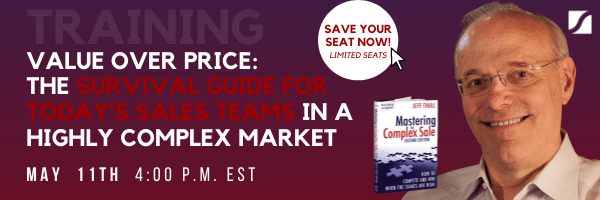3 Steps To Close Complex Sales In The New Normal

In today’s fast-changing world, the stakes are high. And for many companies, they couldn’t be higher. It’s becoming more and more challenging to achieve the level of sales that enables your business to thrive.
Most businesses are doing a lot of things right to satisfy customers: They’re offering competitive solutions that provide value to multiple departments. They’re also following up with high-level service to ensure that customers achieve the results they expect. That makes the marketplace an extremely competitive one.
How can you differentiate your company to consistently achieve a high level of sales success?
What’s the missing piece? A reliable, repeatable sales system executed by well-trained sales professionals that earns your prospects’ trust.
And that’s precisely what I’ll teach you how to implement in this article.
Below, I’ve summed up how you and your team can establish a high-level process for consistently winning complex sales.
First, let’s quickly define what makes a sale complex.
What’s In a Complex Sale?
A complex sale is often a big decision made by multiple people. It may include technical aspects and a large dollar amount. But none of those factors is what actually makes the sale complex.
A complex sale is one in which the customer requires outside expertise to guide them in making a fully informed decision.
Prospects can’t do it as well on their own. But it’s not because they’re not smart and knowledgeable. It’s because they don’t make decisions about the solution you provide very often, and the landscape has evolved since they last did so.
That’s why they require your expert guidance to:
- Diagnose the situation.
Customers lack a system to quantify the performance shortfalls and overall financial impact of their problem. Some may not even recognize that they have a problem. - Design the solution.
Customers don’t know the range of options available or how these might integrate with their current environment. It’s a collaborative effort – they need to work with you to co-design the optimal solution. - Deliver the results.
Customers frequently don't have the internal expertise to carry out a rock-solid implementation that delivers on the solution’s expectations. This is one of the highest-value aspects of any solution—and it falls on you.
As you can see, complex sales are … well, complex. But the sales landscape wasn’t always so sophisticated.
So, how did we get here?
The Evolution of Sales Strategy
Every company makes assumptions that drive how we interact with and sell to customers. There are assumptions about our market, customer, and product, why we built it the way we did, and how we’ll market it successfully.
The problem with assumptions is that we don’t revisit them often enough. What are the assumptions that drive your sales process? More importantly, are they still valid?
Let’s review how the sales landscape has evolved over the last 70 years.
Sales Era 1: The Persuader
In the 1950s, corporations developed systems and scripts to support sales efforts. While the customer was a focus, it was as a victim or target. The “ABCs of selling” were popular: Always Be Closing. The salesperson’s role was that of a strong persuader. Their mantra? “Close early, close often.”
Sales Era 2: The Problem-Solver
In the 1970s, salespeople started paying attention to customers. We’d ask them questions, conduct a needs analysis, build relationships, and listen to what they wanted to buy. The salesperson’s role was that of a problem-solver. Salespeople operated under a very interesting assumption: That the customer understood their problem and knew how to solve it. That being the case, we would match our solution to their vision of what it took to solve the problem.
As we moved from Era 2 to Era 3, the complexity of business problems and their ensuing solutions increased dramatically. As a result, the ability of the customer to self-diagnose and self-design a solution decreased.
Whether you remain in Era 2 or advance to Era 3 depends on your answer to this question: To what degree does your customer understand the full depth and breadth of their problem and the solution you bring?
If the answer isn’t 100%, welcome to Era 3.
Sales Era 3: The Advisor
Today, you and your team conduct a business process analysis, understand how the customer makes money, and how your solutions affect that ability. The salesperson’s role is to offer a business advantage. Instead of questions that the customer could ask and answer, Era 3 sales professionals ask questions the customer wouldn’t think to ask himself. And we take it a step further, asking questions about aspects of their business that the customer wouldn’t think our solution impacts.
Remember, you will differentiate yourself more through the questions you ask than the stories you tell.
Three Challenges of the Complex Sale
Conducting complex sales has its challenges. Try to see them as ways to further differentiate your process from that of competitors. In essence, these challenges and the steps you take to overcome them are what takes your sales process to the next level. Let’s unpack them one by one.
Challenge 1: Decision
Customers don’t have the experience or the cross-functional, objective process for making the decision you’re asking them to make. Ask yourself this fundamental question: To what degree are you providing guidance for the customer to make this complicated decision? Think about how doctors, lawyers, and CPAs function: A high-value component of their solution is that they each bring a high-quality decision process—one that works and one you trust. Why shouldn’t sales professionals bring a similar process to prospects? After all, that’s what business advisors do for their clients.
It's also crucial to remember that we’re not managing a sales process. As sales professionals, we’re leading a decision process.
Challenge 2: Change
When you make a sale, you’re asking customers to make a change—and change is painful. The customer will not change unless the pain of staying the same is greater than the pain of changing. When you start thinking of your sales process as helping prospects make a decision to change, you’ll see a whole different perspective and dimension of your responsibilities.
Challenge 3: Value
The decision to change—or not—is driven by the value your solution brings. As with most business decisions, it boils down to money. You determine a solution’s value by calculating the net profit a prospect is losing by operating without that solution. Customers are typically unable to recognize and quantify this amount. And, most are unable to measure the value a solution provides post-sale. Prospects make decisions based on measurable net value, yet they don’t have the ability to calculate that value without your guidance.
The question is: To what degree are you and your team providing the necessary decision management support, change management support, and value measurement support?
You must provide a robust level of support in all three categories to win complex sales. Let’s explore how you can overcome these challenges and hone your sales system in the process.
Overcoming Challenge 1: Guiding the Decision Process
Decision-making is a process. Guiding that process is a challenge. Your challenge.
Unfortunately, most customers think they know more than they likely do about the potential solutions available. They also think they’re about 60% through their decision process when they reach out to the marketplace.
I’ll raise a caution flag here: If a prospect is that far along in a process that they don’t have full knowledge of, then they’re not as far along as they think.
If you engage with the customer at this moment, they’re eager to move the process forward and make a decision. However, they may not fully understand the scope of their problem or the extent of your solution.
When “amateur” salespeople jump in at this point, they want to close the deal quickly. They make promises about how great their solution is, and why it’s better than the alternatives. Their mistake is that the customer has self-diagnosed. Therefore, the odds that the solution they’ll provide is the ideal one are low.
You absolutely cannot differentiate yourself and your solution when you jump into the sales process mid-stream. You need to back up to an earlier part of the process: the diagnostic conversation.
It’s in your best interest to guide the customer back to the critical part of the process where they make the decision about why they should change—based on the evidence in their current reality.
Diagnosing their situation thoroughly before they make the decision to change will empower you to design the ideal solution for the circumstances at hand.
Overcoming Challenge 2: Guiding Prospects to Embrace Change
How do you help prospects decide that they’re ready to change? You must illuminate their current reality—thorns and all. This increases their understanding that it’s more painful to stay where they are and do nothing than it is to make a change.
Most prospects are operating in a realm known as the “Positive Present.” They’re not thinking about any problems. Operations are running more or less smoothly, and they’ve gotten good at accepting any evidence of problems as normal.
Traditional sales techniques usher prospects from the Positive Present into an even rosier future where their solution provides benefits galore. Amateur salespeople want to keep things positive—it’s all sunshine and rainbows. Why cause the customer to worry when your solution can fix it?
However, the interesting thing that high-level sales professionals do—which is contrary to the sunshine and rainbows technique—is to draw attention to the negative. When you uncover the extent and reach of a problem, the customer begins to see that while they thought they were in the Positive Present, they’re actually in the Negative Present.
The Negative Present is where the customer sees that things aren’t as rosy as they thought. With your guidance, they understand how the current situation is negatively impacting the organization’s productivity and profit.
The Negative Present is where you diagnose the problem based on evidence. It’s also where the customer decides they’re going to change.
From the Negative Present, prospects have two options:
- Remain and experience the pain―which may get worse
- Change, and face the pain of change to avoid the Negative Future
When you define the negative impact of the problem and explore the consequences of an even more Negative Future that the customer wants to avoid, the customer decides to change. And then you continue the journey together.
When your prospect understands that their current situation isn’t ideal and could even get worse if they don’t take action, they have the incentive to change.

Overcoming Challenge 3: Value Communication vs. Value Clarity
“The problem with communication is the illusion that it has been accomplished.” – George Bernard Shaw.
That quote describes the sales process perfectly!
Salespeople think we’ve communicated the value of our solution. We’ve shown the prospect the value, the benefits, and backed those up with business case studies. The prospect smiled and nodded. But while we may have communicated the value, we really haven’t clarified the value.
How do you clarify your solution’s value? By examining specific business processes in your customer’s organization, measuring their output level, and interpreting that with a financial impact that represents the impact of your solution.
Once you connect money to the prospect’s issue, you’ve quantified its value—and the issue becomes real.
As the sales professional, it’s up to you to provide the formula that will enable your customer to quantify the performance impact that your solution can provide.
In other words, show them the money!
The tool you use to do this must be so comprehensive and bulletproof that the customer looks at your formula and says, “That is thorough, complete, and objective. Here’s my data. Let’s plug it into your formula.”
Whether your tool is a written assessment or a business simulator, it must be based on a very well-defined process. You must incorporate specific symptoms that yield specific measurements. Give prospects a well-defined process that enables them to plug in their data and see your solution’s value. That’s how you guide their understanding and their decision to make this change.
Is it a lot of work? Yes. But spectacular success comes from unspectacular preparation. Once that preparation is done, it doesn’t have to be re-done. Other prospects are essentially running the same processes, so you’ll use that well-designed formula over and over.
You provide the formula; the prospect provides the data. When you can both see the results and objectively agree on how much it’s costing them to remain in their current situation―that’s value clarity.
There’s one additional step you can take to make sure you’re illuminating the full extent of your solution’s value - and develop your own understanding of it. After all, you don’t want to present anything less than everything your prospect will enjoy after implementation.
Be Ready to Overcome the Value Challenge
As you design your value clarification formula, be sure to include the full scope of value you’ll provide. In my experience, even the best business cases include less than 30% of their solution’s actual value.
We teach sales professionals how to determine with prospects 100% of their solution’s value. How can you increase the value you demonstrate by such a dramatic percentage?
You do so by including all three levels of value:
- Product/service level
It’s the most tangible—speed, durability, required maintenance, etc. Most salespeople are well-versed in portraying value at this level. - Process level
Most salespeople do a good job of showing how their product helps to improve a specific business process. What they don’t do well is to quantify that process value upstream, downstream, for simultaneous processes, in consecutive processes, and accounting for the ripple effect of these multiple processes’ indirect impacts across the organization. - Performance level
Most salespeople fail to show even very little of how their solution impacts the prospect’s overall business outcomes. Such metrics include the change in market share, overall profit, and Net Promoter Scores. The performance-level impact is the Holy Grail of your solution’s value. You must hone your ability to define this level of value so that it’s very, very clear. Doing so differentiates you from the pack.
While clarifying your solution’s overall value at the performance level sounds daunting, in our upcoming course, I’ll teach you how to do so, step-by-step.
Here’s one method we’ll go over: Create a value matrix from the customer’s Key Performance Indicators (KPIs) and your solution’s features. If the prospect has 18 KPIs and your solution has 16 features, that’s a total of 288 potential value intersections. That means there are 288 places in the customer’s organization where your solution could benefit a business performance issue.
However, you’re obviously not going to go over all 288 of them during your meeting. That would take hours! But do lay them out in a grid, and identify the top customer performance issues that your product capabilities address. You may determine that five of those 288 intersections constitute a high percentage of your solution’s value to the prospect. Then focus your diagnosis on those five.
When the customer sees your value matrix grid representing 288 possible areas of benefit, they immediately recognize that you genuinely understand their type of business and its challenges. Well done—you’ve just earned their trust and respect.
Why it’s Critical to Establish Your Sales System
Why is it so important to have a well-established sales system? Because in today’s market, you’re either part of your system―or somebody else’s. If you don’t approach the marketplace with a well-defined system that you believe in, you’ll be drawn into either your customer’s or your competitor’s system. And that’s not where you’ll win the sale.
Think about how other respected professionals operate. When you go to a doctor, lawyer, or CPA, are you operating in your system or their system?
We appreciate and value the systems that these professionals provide. They help us make critical decisions where we need guidance.
That’s exactly what you want to do and how you want to be seen—you want prospects to appreciate and value your sales system. That’s what differentiates you in the crowded, competitive marketplace.
Top sales professionals take the sales process to a scientific level, demonstrating high-level insight into a prospect’s process and collaborating on the ideal high-value solution.
Professional customer guidance and a robust level of support at every juncture are the keys to complex sales success.
When you build your system, engage the customer, and own the process—you’ll win the sale.



